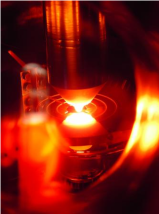
A pre-prepared, cleaned polycrystalline silicon rod is positioned in a chamber in a controlled atmosphere. By means of a high-frequency induction coil as a heat source, a relatively narrow zone of the material is melted in a contact-free manner at the bottom end. So that the zone melts evenly, the rod is slowly rotated. The melted zone is put in contact with a monocrystalline seed crystal and grows, adopting its crystal structure and orientation. This melting zone is now slowly moved axially through the rod. As the melt cools down again, it solidifies across the entire crystal diameter with a uniform crystal structure so that the desired monocrsytal forms behind the melting zone.
The advantage of floatzone method is the melted silicon won’t have any contact with the crucible during the whole process. As the result, the purity of the ingot is pretty high, also with higher conversion efficiency. It becomes the ideal method to make solar cells.
From the late 50s when the floatzone method was invented, PVA TePla had kept researching and producing the semiconductor grade silicon vigorously. From the beginning to nowadays, we have invented and developed a lot of special systems to produce mono ingots. Until now, PVA TePla is still one of the most important suppliers in this area, especially in the field of floatzone, we are the no doubt the most outstanding one.

